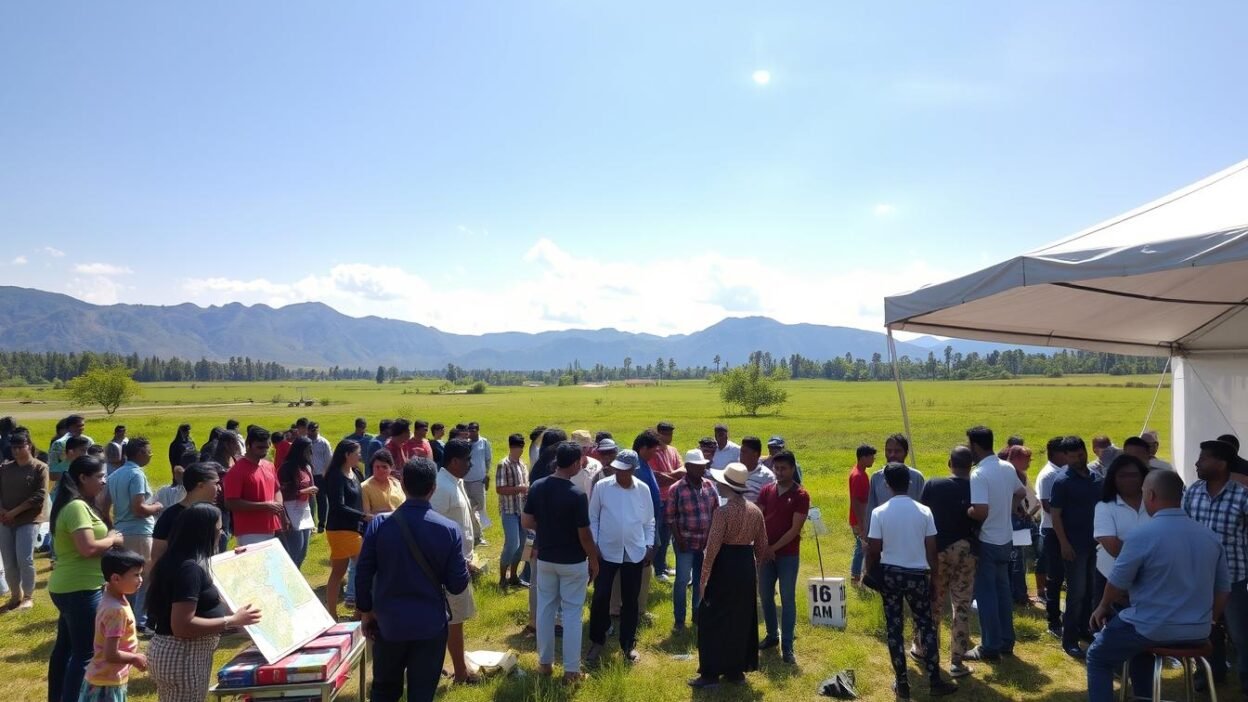India faces a daunting challenge: 85% of its land is at risk of multiple natural hazards. This affects millions of lives every year. Community education offers a powerful solution to this pressing issue.
Mitigate Natural Hazards:
By empowering communities with knowledge and skills, we can lessen disaster impacts. This approach saves lives, reduces economic losses, and safeguards critical infrastructure. Across India, communities are becoming proactive in disaster risk reduction.
From Kerala’s flood-prone areas to Uttarakhand’s earthquake-prone regions, education programs are making a difference. These initiatives blend traditional wisdom with modern technology. They’re reshaping India’s disaster preparedness landscape for future generations.
Preparing for the UGC NET exam can be a daunting task, but with the right resources, candidates can navigate the process effectively. Websites like MyJRF provide a comprehensive platform for aspiring educators, offering specialized guidance for UGC NET Paper 2 preparation and essential tips for acing UGC NET Paper 1. Additionally, understanding the revised syllabus provided by UGC is crucial for a targeted study approach. For official announcements and updates, candidates should regularly visit the UGC NET NTA portal, while the UGC’s job section and the main UGC website are invaluable for post-exam opportunities and academic resources. With these tools, candidates can maximize their preparation and set themselves up for success.
Key Takeaways
- 85% of India’s land area faces multiple natural hazard risks
- Community education is crucial for effective disaster risk reduction
- Knowledge empowers communities to become proactive in hazard mitigation
- Blending traditional wisdom with modern technology enhances preparedness
- Education initiatives are reshaping India’s approach to natural hazards
Understanding Natural Hazards in India
India faces many natural hazards due to its vast geography and varied climate. These challenges show the need for strong disaster preparedness across the country. Effective risk management strategies are crucial for India’s safety.
Common Types of Natural Hazards
India experiences several types of natural disasters:
- Floods: Affecting riverine areas and coastal regions
- Earthquakes: Frequent in the Himalayan belt and parts of central India
- Cyclones: Impacting coastal states, especially along the Bay of Bengal
- Droughts: Recurring in arid and semi-arid regions
Regional Variations in Hazards
The risk of natural disasters varies across India’s regions:
- North: Prone to earthquakes and landslides
- East: Vulnerable to cyclones and floods
- West: Faces droughts and occasional earthquakes
- South: Experiences cyclones and coastal flooding
Impact of Climate Change
Climate change intensifies natural hazards in India. Rising temperatures lead to more frequent and severe events. Adapting to these changes is crucial for India’s future.
Some effects of climate change include:
- Increased flooding due to heavy rainfall
- More intense cyclones in coastal areas
- Prolonged droughts affecting agriculture
- Sea-level rise threatening coastal communities
Understanding these hazards is key to creating effective disaster plans. It also helps in implementing climate change measures across India. Better preparation can save lives and protect communities.
The Importance of Community Education
Community education is crucial for building disaster resilience. It equips people with vital knowledge and skills. This preparation creates safer communities ready to face natural hazards.
Building Awareness and Preparedness
Effective hazard assessment begins with community awareness. Educational programs help residents understand local risks. They also assist in developing emergency response plans.
- Public workshops on disaster preparedness
- Distribution of informational materials
- Regular community drills and exercises
Empowering Local Leaders
Community education empowers local leaders during crises. Training programs focus on essential skills for neighborhood guidance.
- Crisis management skills
- Coordination with emergency services
- Effective communication during disasters
Promoting Self-Sustainability
Self-reliant communities show greater resilience. Education initiatives teach valuable skills for disaster preparedness.
| Skill | Benefit |
|---|---|
| First aid | Immediate medical assistance |
| Water purification | Access to safe drinking water |
| Basic construction | Temporary shelter building |
Investing in community education builds long-term disaster resilience. These programs empower individuals to protect themselves and their neighbors. Active participation in safety measures becomes a community-wide effort.
Effective Communication Strategies
Effective communication is vital for disaster and hazard mitigation. Various methods help reach a wider audience. This ensures crucial information is understood and acted upon.
Utilizing Social Media and Technology
Social media platforms spread awareness about natural hazards effectively. Facebook, Twitter, and WhatsApp groups quickly share alerts and safety tips. Mobile apps offer real-time updates on weather conditions and evacuation routes.
Creating Informative Workshops
Hands-on workshops teach community members about hazard mitigation strategies. These sessions cover topics like emergency kits, evacuation procedures, and basic first aid. Interactive activities help participants remember information better than passive learning methods.
Developing Educational Materials
Well-designed brochures, posters, and videos educate the public about disaster risks. These materials use simple language and clear visuals to explain complex concepts. Distributing them in schools, community centers, and public spaces ensures wide reach.
| Communication Method | Advantages | Challenges |
|---|---|---|
| Social Media | Rapid dissemination, wide reach | Digital divide, misinformation risks |
| Workshops | Interactive learning, skill-building | Limited attendance, resource-intensive |
| Educational Materials | Permanent reference, language flexibility | Production costs, distribution logistics |
Combining these strategies creates a thorough approach to public education. This helps communities learn about disaster and hazard mitigation measures effectively.
Collaboration with Local Organizations
Strong partnerships are key to effective disaster risk reduction. Local organizations play a vital role in these efforts. Together, communities can build resilience against natural hazards.
Involving NGOs and Community Groups
NGOs and community groups bring valuable resources to the table. They possess deep local knowledge and established networks. These groups help spread awareness and organize volunteer efforts for disaster preparedness.
Partnering with Government Agencies
Government agencies provide crucial support for emergency response planning. They offer funding, expertise, and equipment. Working with these agencies ensures a coordinated approach to disaster management.
Engaging Educational Institutions
Schools and universities are essential for disaster education. They can teach risk reduction concepts in their classes. This fosters a culture of preparedness among young people.
| Organization Type | Key Contributions | Collaboration Benefits |
|---|---|---|
| NGOs | Local knowledge, volunteer networks | Enhanced community outreach |
| Government Agencies | Funding, expert guidance, equipment | Coordinated disaster response |
| Educational Institutions | Research, youth education | Long-term resilience building |
These partnerships create strong strategies for disaster risk reduction. They improve emergency response planning. As a result, communities become safer and more resilient.
Training Programs for Community Members
Training programs are vital for disaster preparedness in communities. They teach essential skills for emergency response and hazard mitigation. These programs help people handle crises and reduce risks effectively.
First Aid and Emergency Response
First aid training is key to community disaster readiness. It teaches how to assess injuries and perform CPR. Participants learn basic medical care for emergencies.
These skills can save lives before professional help arrives. Quick action in emergencies can make a big difference.
Disaster Risk Reduction Techniques
Risk reduction training focuses on preventing and minimizing damage. People learn to spot potential dangers in their surroundings. They also discover ways to lessen these risks.
Training covers proper food storage and securing loose items. Creating emergency plans is another important part of this preparation.
Simulation and Drills
Regular practice helps put learned skills to use. Simulations familiarize people with emergency procedures. They also test how well risk management plans work.
Drills cover various scenarios like earthquakes and floods. This ensures communities are ready for different types of emergencies.
| Training Component | Key Skills | Benefits |
|---|---|---|
| First Aid | CPR, wound care, triage | Immediate life-saving response |
| Risk Reduction | Hazard identification, mitigation planning | Reduced vulnerability to disasters |
| Simulations | Emergency protocols, team coordination | Improved response time and efficiency |
These training programs boost community disaster preparedness. They help people respond better to emergencies. As a result, communities become more resilient against natural hazards.
Role of Schools in Education
Schools shape young minds and prepare them for the future. In India, they’re adding disaster resilience to their lessons. This helps students understand hazards and climate change adaptation early on.
Educational institutions are vital in developing resilient communities. They equip students with knowledge to face environmental challenges. This approach is crucial for India’s future safety.
Incorporating Natural Hazard Education
Schools blend natural hazard education into various subjects. Science classes explore disaster causes. Geography lessons focus on vulnerable regions. Math classes use real-world data to analyze disaster trends.
Facilitating Field Trips and Experiences
Hands-on learning is key to disaster resilience education. Schools organize trips to disaster-prone areas. Students witness the impact of natural hazards firsthand.
These experiences make abstract concepts real. They inspire students to take action in their communities. Field trips connect classroom learning to real-world situations.
Fostering a Safety Culture
Building a safety culture is crucial for long-term disaster resilience. Schools conduct regular emergency drills. They teach students how to respond during crises.
Schools also promote sustainable practices. They link everyday actions to climate change adaptation. This approach ensures students become safety advocates at home and in neighborhoods.
“Education is the most powerful tool we have to create a safer, more resilient future for India,” says Dr. Rajesh Kumar, a leading expert in disaster management education.
Schools prioritize hazard education to prepare the next generation. They provide knowledge and skills to face environmental challenges. This proactive approach is essential for building a more resilient India.
Leveraging Technology in Education
Technology is key in educating communities about natural hazards. Digital tools spread awareness and provide vital information. They help mitigate natural hazards effectively.
Innovative methods are being used in disaster mitigation measures. These technologies enhance community preparedness and response to potential threats.
Mobile Apps for Hazard Awareness
Smartphone apps are powerful tools for disaster preparedness. They offer real-time alerts, safety tips, and evacuation routes. India’s National Disaster Management Authority launched “Disaster Alert” to inform citizens about potential threats.
Online Learning Platforms
E-learning platforms provide accessible education on natural hazards. Courses cover topics from basic preparedness to advanced risk assessment. Many organizations offer free online modules to help communities prepare for disasters.
GIS and Mapping Technologies
Geographic Information Systems (GIS) create detailed hazard maps. These maps show vulnerable areas and safe zones, aiding in disaster planning. Communities use this data to identify evacuation routes and plan emergency responses.
| Technology | Application in Disaster Mitigation |
|---|---|
| Mobile Apps | Real-time alerts, safety tips |
| Online Platforms | Educational courses on preparedness |
| GIS Mapping | Hazard mapping, evacuation planning |
Communities can enhance their ability to mitigate natural hazards using these technologies. Mobile apps, online learning, and mapping tools create a powerful framework for disaster preparedness.
Case Studies of Successful Initiatives
India has made great strides in disaster resilience. Several states have implemented effective strategies for reducing disaster risks. These success stories offer valuable insights for the entire country.
Learnings from Kerala Floods
The 2018 Kerala floods sparked innovative community responses. Local groups used WhatsApp to coordinate rescues and share updates. This grassroots approach saved lives and distributed aid efficiently.
Effective Responses in Uttarakhand
Uttarakhand improved its disaster preparedness after the 2013 floods. The state set up an early warning system with sirens and SMS alerts. This tech-driven approach has enhanced the region’s ability to respond quickly to hazards.
Community Resilience in Maharashtra
Maharashtra’s ‘Village Disaster Management Committees’ are a model for community resilience. These groups train locals in first aid, search and rescue, and evacuation. Their efforts have significantly reduced casualties during cyclones and floods.
| State | Initiative | Impact |
|---|---|---|
| Kerala | Community WhatsApp Networks | Improved rescue coordination |
| Uttarakhand | Early Warning System | Faster disaster response |
| Maharashtra | Village Disaster Management Committees | Reduced disaster casualties |
These examples show how communities and technology can build disaster resilience. They provide key lessons for improving disaster risk reduction across India. By applying these strategies, other regions can better prepare for future challenges.
Building Resilient Infrastructure
Resilient infrastructure is vital for disaster preparedness in India. Communities need education on safe building practices. This knowledge helps create structures that can withstand natural hazards.
Educating on Safe Building Practices
Safe construction techniques are crucial for disaster mitigation. Communities learn to use strong materials and follow building codes. This education helps create homes that can resist earthquakes, floods, and cyclones.
Promoting Eco-Friendly Solutions
Eco-friendly building methods support climate change adaptation. Green roofs absorb rainwater and cool urban areas. Solar panels provide clean energy during power outages.
Advocating for Sustainable Development
Sustainable development is key to long-term disaster preparedness. It involves planning cities with green spaces and water systems. This approach helps communities cope with extreme weather events.
| Building Practice | Disaster Mitigation Benefit | Sustainability Impact |
|---|---|---|
| Raised foundations | Flood protection | Reduces water damage |
| Reinforced concrete | Earthquake resistance | Increases building lifespan |
| Green infrastructure | Stormwater management | Enhances biodiversity |
India can build a more resilient future by focusing on these areas. Safe and eco-friendly infrastructure is essential. It helps with disaster preparedness and climate change adaptation.
The Role of Local Government
Local governments protect communities against natural hazards. They create policies, allocate funds, and build capacity for risk management. Their efforts support community safety and preparedness.
Policies for Community Engagement
Local governments create policies for citizen participation in hazard assessment. They also involve residents in emergency response planning. This approach builds a culture of preparedness and shared responsibility.
- Regular town hall meetings to discuss local risks
- Volunteer programs for community-based disaster response teams
- Public awareness campaigns about potential hazards
These policies help residents understand their role in community safety. They also encourage active participation in risk management efforts.
Funding for Education Programs
Local governments invest in hazard mitigation education. They allocate resources for developing educational materials and training local educators. Community drills and simulations are also organized to enhance preparedness.
- Develop educational materials on risk management
- Train local educators in emergency response techniques
- Organize community drills and simulations
These investments build a knowledgeable community. They help residents prepare for potential disasters effectively.
Enhancing Local Capacity
Local governments improve their hazard assessment and response capabilities. They hire specialized staff and upgrade early warning systems. Collaboration with experts helps refine local emergency plans.
- Hiring and training specialized staff in disaster management
- Upgrading technology for early warning systems
- Collaborating with experts to improve local emergency plans
These efforts strengthen local authorities’ ability to protect communities. They ensure effective responses to emergencies.
“Local governments are the first line of defense in protecting communities from natural hazards. Their commitment to education and preparedness is crucial for building resilient cities and towns.”
Measuring the Impact of Education
Evaluating community education programs is vital for boosting disaster resilience. Measuring impact helps refine hazard mitigation strategies. It also improves disaster risk reduction efforts.
Surveys and Feedback Mechanisms
Surveys offer valuable insights into community awareness and preparedness. Online questionnaires and interviews help assess understanding of local hazards. They also gauge knowledge of emergency procedures.
Feedback from these surveys guides the creation of targeted education initiatives. This ensures that programs address specific community needs.
Long-Term Community Outcomes
Assessing long-term outcomes shows the true impact of education on disaster resilience. Key indicators include:
- Reduction in disaster-related injuries and fatalities
- Increased adoption of hazard mitigation strategies
- Improved community response during emergencies
- Enhanced disaster risk reduction practices in daily life
Adapting Strategies Based on Results
Data-driven adjustments are crucial for effective disaster education. Analyzing survey results and long-term outcomes helps educators improve their methods.
- Identify knowledge gaps and misconceptions
- Tailor content to specific community needs
- Develop innovative teaching methods for complex topics
- Allocate resources to high-impact educational programs
Ongoing evaluation ensures community education stays relevant in building disaster resilience. It allows for timely adjustments to maximize impact.
Promoting a Culture of Preparedness
Disaster preparedness is crucial for mitigating natural hazards in India. It aims to make readiness a part of daily life. This ensures communities can face challenges effectively.
Encouraging Continuous Learning
Risk management education should be ongoing. Communities can host regular workshops on disaster preparedness. These sessions keep people informed about new threats and safety measures.
Celebrating Successes
Recognizing community efforts in disaster preparedness boosts morale. Villages that successfully mitigate natural hazards deserve honor. This recognition inspires others to take similar actions.
| Achievement | Recognition |
|---|---|
| Flood-resistant housing | Community resilience award |
| Early warning system | Innovation in safety certificate |
| Disaster response team | Preparedness excellence medal |
Inspiring Future Generations
Schools play a vital role in fostering preparedness. Adding disaster risk reduction to curricula helps children understand safety’s importance. This knowledge shapes future leaders who prioritize hazard mitigation.
“Empowering youth with disaster preparedness skills creates a safer tomorrow for all of India.”
Continuous learning, success celebration, and youth inspiration build lasting preparedness. This approach keeps communities ready to face natural hazards. India can effectively mitigate risks through these strategies.
Conclusion: The Path Forward
India’s disaster resilience journey needs ongoing education. Empowering communities with knowledge builds a safer future. This approach enhances preparedness and fosters proactive disaster mitigation.
Commitment to Ongoing Education
Continuous learning helps adapt to changing natural hazards. Climate change adaptation requires evolving educational programs. Regular updates to curricula ensure communities stay ahead of potential risks.
Collaboration Among Stakeholders
Strong partnerships between agencies, NGOs, and communities are crucial. Pooling resources creates robust disaster mitigation measures. This approach maximizes the impact of educational initiatives.
Vision for a Safer Future in India
India’s future lies in empowered communities ready for natural hazards. Sustained education efforts build disaster-resilient societies. This vision promises thriving communities that stand strong against nature’s challenges.
FAQ
What are the most common natural hazards in India?
India faces floods, earthquakes, cyclones, and droughts as common natural hazards. These disasters vary across regions and have worsened due to climate change. Their impact has become more severe in recent years.
How can community education help mitigate natural hazards?
Community education is vital for reducing disaster risks. It builds awareness and empowers local leaders to prepare for emergencies. This approach equips people with skills to handle natural disasters effectively.
What are effective communication strategies for disaster preparedness?
Social media, technology, and workshops are key for disaster preparedness communication. These methods spread crucial information about hazard mitigation and emergency procedures. They help reach diverse audiences with important safety messages.
How can schools contribute to natural hazard education?
Schools can include natural hazard education in their lessons. They can organize field trips and hands-on experiences for students. This approach builds long-term disaster resilience in communities.
What role does technology play in community education for natural hazards?
Technology enhances community education through mobile apps and online learning platforms. It makes hazard awareness information more accessible and engaging. GIS mapping tools also help in educational efforts.
How can local governments support community education initiatives?
Local governments can create policies for community engagement. They can fund education programs and improve local capacity. These actions are crucial for effective hazard mitigation planning.
What are some successful community education initiatives in India?
Kerala’s flood response and Uttarakhand’s effective measures are notable successes. Maharashtra’s community resilience efforts also stand out. These examples offer insights into best practices for disaster risk reduction.
How can we measure the impact of community education programs?
Surveys and feedback help measure program impact. Assessing long-term community outcomes is also important. Adapting strategies based on results improves disaster preparedness efforts.
What is the importance of promoting a culture of preparedness?
A culture of preparedness is key to long-term disaster resilience. It encourages ongoing learning and inspires future generations. This approach helps communities become proactive in handling natural hazards.
How does climate change impact natural hazards in India?
Climate change is making natural hazards in India more frequent and intense. It affects weather patterns, causing severe floods, droughts, and cyclones. Education on climate change adaptation is crucial for managing these risks.





